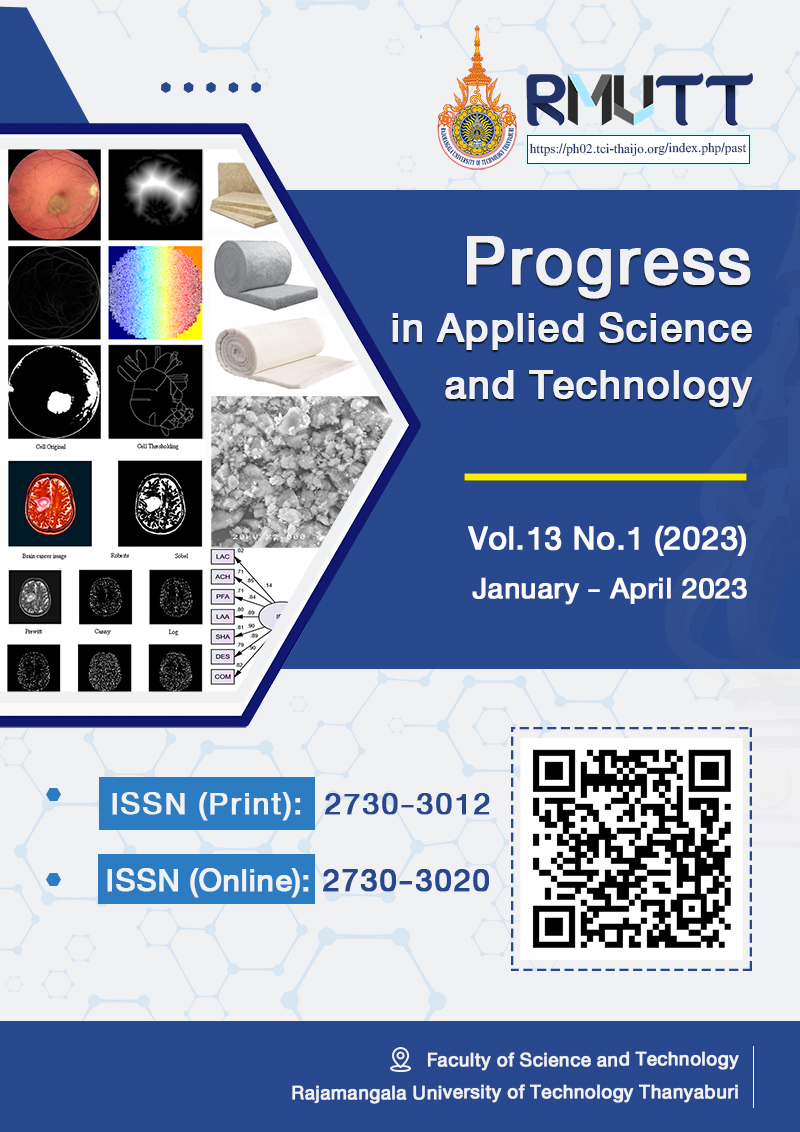Potential of Pineapple Leaf Fibers as Sound and Thermal Insulation Materials in Thailand
Main Article Content
Abstract
The objectives of this research were to create a database of botanical characteristics including fiber morphology, chemical composition and physical properties of pineapple leaf fiber (PALF) from different areas of Thailand. Production efficacy and potential of PALF panel as sound and thermal insulation material were also investigated. Information on the botanical characteristics and morphology of Batavia pineapple leaf fibers from different areas of Thailand and commercial sound and thermal insulation products made from various materials was collected and used as primary and secondary data for business feasibility analysis as technique, cost and market. Results showed that thermal properties of PALF composites were better than commercial composites containing asbestos and PET fiber and similar to glass fiber composites. The sound absorption property of PALF composites was lower than polyester fiber but better than glass fiber and comparable with asbestos. The noise reduction coefficient (NRC) value of PALF composite products was lower than sound insulation materials made of PET fiber, a similar type of material to PALF composites. The developed PALF sound absorption and heat insulation panel showed promise as a commercial product in terms of production technology, market trend and competitive cost.
Article Details

This work is licensed under a Creative Commons Attribution-NonCommercial-NoDerivatives 4.0 International License.
References
Todkar SS, Patil AA. Review on mechanical properties evaluation of pineapple leaf fibre (PALF) reinforced polymer composites. Compos. B. Eng. 2019;174:1-16.
United Nations Industrial Development Organization [Unido]. Thermal Insulation Properties and Applications in Housing Technical Manual. Austria:Unido; 2017.
Mohanty AK, Misra M, Hinrichsen G. Biofibres, biodegradable polymers and biocomposites: An overview. Macromol. Mater. Eng. 2000;276-277:1-24.
Chollakup R, Tantatherdtam R, Ujjin S, Sriroth K. Pineapple leaf fiber reinforced thermoplastic composites: Effect of fiber length and fiber content on their characteristics. J. of Applied Polym. Sci. 2011;119:1952-1960.
Chollakup R, Askanian H, Delor-Jestin F. Initial properties and ageing behavior of pineapple leaf and palm fibre as reinforcement for polypropylene. J. Thermoplast.Compos.Mater. 2016;30(2):1-22.
Smitthipong W, Tantatherdtam R, Chollakup R. Effect of pineapple leaf fiber (PALF) reinforced thermoplastic starch (TPS)/PLA green composite: Mechanical, viscosity and water resistance properties. J. Thermo. Compos. Mater. 2015;28:717-729.
Suwanruji P, Tuechart T, Smitthipong W, Chollakup R. Modification of pineapple leaf fiber for reinforcement thermoplastic composites by silane and isocyanate surface treatments. J. Thermoplast. Compos. Mater. 2017;30:1344-1360.
Occupational Health Environmental Health Division. Lung and lung disease. Bangkok: Bureau of Health Ministry of Public Health. Leaflet; 1996.
Zabalza I, Bribia AV, Capilla A, Uson A. Life cycle assessment of building materials: comparative analysis of energy and environmental impacts and evaluation of the eco-efficiency improvement potential, Build. Environ. 2011;46:1133-1140.
Chandramohan D, Marimuthu K. A review on natural fibres. Int. J. Res. Rev. Appl. Sci. 2011;8:194-206.
Papadopoulos AM. State of the art in thermal insulation materials and aims for future developments. Energy and Buildings. 2005;37:77-86.
Sutton A, Black D, Walker P. Natural fibre insulation : An introduction to low-impact building materials. Information Paper, 1st BRE publications. 2011;1-4.
Franklin GL. Preparation of thin section of synthetic resins and wood-resins composite, and a new method for wood. Nature. 1945;155:3924-3951.
Koizumi T, Tsujiuchi N, Adachi A. The development of sound absorbing materials using natural bamboo fibres. High performance structures and materials, 4th C.A. Brebbia and W.P.De Wilde Eds. Southampton: WIT Press, 2002;157-166.
Seddeq HS. Factors influencing acoustic performance of sound absorptive materials. Aust. J. Basic & Appl. Sci. 2009;3:4610-4617.
BAUX Acoustic Company: https://www.baux.com/acoustic-products/ wood-wool/tiles/baux-wood-wool-tiles-square/; 2021.
Markets and Markets. Building Thermal Insulation Market by Material - Global Forecast to 2022 https://www.marketsandmarkets.com/; 2017.
Markets and Markets. Building Thermal Insulation Market by Material - Global Forecast to 2027 https://www.marketsandmarkets.com/; 2022.
Francesco A, Francesco D, Samuele S. A review of unconventional sustainable building insulation materials. Sustainable Materials and Technologies. 2015;4:1-17.
Friedlingstein P, et al.Global Carbon Budget 2022, Earth System Science Data.2022; doi: 10.5194/essd-14-4811-2022
GLER (Thailand) Co., Ltd. Acoustic Solution [PowerPoint slides]. GLER (Thailand) Co., Ltd. https://www.glerthailand.com/; 2021.






